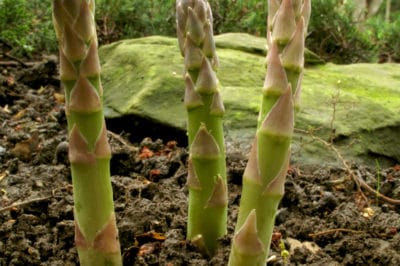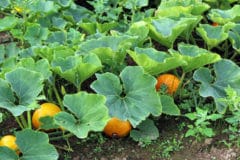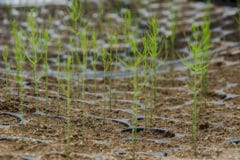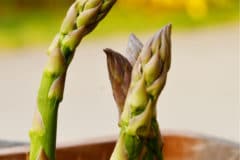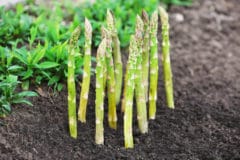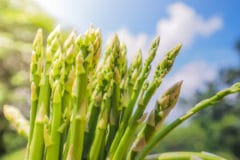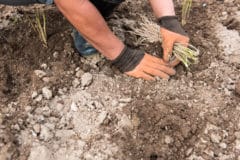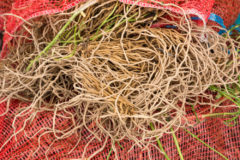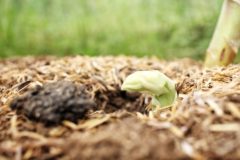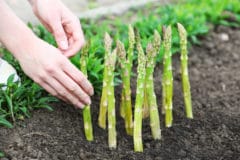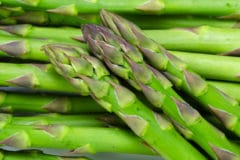How do you choose a good site for planting asparagus?
Because asparagus grows in the same place for many years, choose the planting location carefully. Good drainage is essential. To find out how well the soil drains, dig a hole 1 foot (30cm) wide and deep and fill it with water. When the water drains out, fill it again and time how fast it drains. If 1 to 4 inches (2.5 to 10cm) drain out in one hour, drainage is adequate. If it drains faster or slower, consider building a raised bed and importing better soil for your asparagus bed.
What kind of soil does asparagus like?
Asparagus grows best in fertile, well-drained soil with a pH of 6.5 to 7. Add generous amounts of organic matter to the planting area before planting. Good sources of organic matter are:
- Compost
- Leaf mold
- Decomposed manure
How much sun does asparagus need?
Asparagus grows best in full sun, but it can also tolerate a bit of shade. However, a sunny location will produce more abundant crops.
How long does it take for asparagus to grow?
Asparagus crowns need two years of growth before you can harvest more than a few spears. If you start this crop from seed, you will have to wait an additional year. With crowns, you can pick a few spears in the second year, but wait until the third season after planting to harvest a good size crop from crowns, and wait until the fourth year if you have started the plants from seeds or seedlings.
When is the best time to plant asparagus?
Plant asparagus crowns and seeds in the fall or spring in areas with mild winters. In areas with cold winters, wait until spring when the soil temperature is over 50ºF (10ºC) before planting.
Is it better to plant male or female plants?
Asparagus plants are either male or female, and it is the male plants which produce better crops. The reason for this is that female plants produce berries, and this takes up substantial energy, reducing the quality and yield of spears. Some popular all-male asparagus varieties are:
- Backlim
- Eros
- Jersey Knight
- Jersey Giant
- Lucullus
- Grolim
How far apart should you plant asparagus crowns?
Place asparagus crowns between 9 and 18 inches (23 to 46cm) apart in rows. Leave at least 3 feet (.9 meters) between rows.
How deep should you plant asparagus crowns?
First dig a trench about 18 inches (46cm) wide and 6 to 8 inches (15 to 20cm) deep. If your soil is light, set the crowns at 8 inches (20cm) deep. In heavy soil, plant them at 6 inches (15cm) deep. Cover them with soil, filling to the top of the trench, and be sure to set the crowns with the central bud facing upwards and spread out the roots around the bud.
How much water does asparagus need?
Asparagus needs lots of water, especially when the ferns are growing in summer. Keep the soil moist but not soggy to a depth of 2 feet (.6 meters) after first planting the crowns, and after they are established, water them deeply after harvest in June and through the end of August. Established plants generally do not need additional water in spring, unless conditions are very dry. Stop watering in the fall to allow the roots to go into dormancy.
When do you fertilize asparagus?
Before you plant the crowns or seeds, mix compost into the planting area to give the plants plenty of nutrients to start. Also, add a source of phosphorous, such as bone meal or rock phosphate, to the bottom of the planting trench and stir it into the soil before planting. Next, dress the top of the bed with a ballanced fertilizer in early spring the first year. After that, fertilize the bed each season in June with a fertilizer containing nitrogen, phosphorous, potassium, and trace minerals. Good organic sources of these minerals include:
- Blood meal and fish meal for nitrogen
- Bone meal and rock phosphate for phosphorous
- Granite dust for potassium
- Kelp meal for trace minerals
When do you harvest asparagus?
Resist the temptation to harvest any spears in the first year. In the first year, the roots need as much energy as possible from the mature ferns in order to develop completely. In the second year, harvest only a few spears, if any. In the third spring, you can harvest all the spears from the time they appear until June, but then stop so some can develop into ferns and provide nutrients to the large root system.
How many crowns should I plant?
Each mature crown will produce about ½ pound (.23 kilograms) of spears each spring. Planting 12 crowns per person, or about 50 crowns for a family of four provides a bountiful harvest for most people. However, if you plan on freezing or canning some of the harvest, plant more.
Can you eat asparagus berries?
No, they are toxic. Berries are primarily produced by female plants, and female plants do not produce spears as well as male plants. Also, when berries fall to the ground they can be an unwanted source of volunteer sprouts which need to be weeded out. However, asparagus berries do have some uses. For one, they are attractive and can be used in floral arrangements. They also contain seeds which can be dried and then used to grow new crowns for planting.
How do you harvest asparagus spears?
Wait until the spears are approximately 8 inches (20cm) tall to harvest them. Then, simply snap them off at the base by holding them firmly and bending them to the side. If you use a knife to cut them, be careful not to cut into other spears still in the ground or into the root system.
Should you cut down asparagus ferns at the end of the season?
Yes. However, do not cut them too early, as the dying ferns return nutrients to the roots as they dry out. Also, in areas with snow, the ferns can catch additional moisture and help direct it to the roots.
What pests and diseases attack asparagus?
Asparagus is a hardy vegetable which is not prone to pest and disease problems when grown under the right conditions. However, the following can be a problem:
- The black and white marked asparagus beetle feeds and lays eggs on growing spears. The larvae over-winter in the soil and then emerge in spring.
- Asparagus aphid is a small, sucking insect which attacks the ferns by injecting a toxin into the plant, causing new shoots to become short and bushy.
- Fusarium oxysporum is a soil born pathogen which affects the water transporting system of the plants, causing wilting of spears and stalks.
The best control for pests and disease is keeping the plants healthy by fertilizing and watering correctly and removing old foliage at the end of the season. You can also look for pest-resistant varieties in areas with extreme pest problems.
What plants grow well near asparagus?
Tomatoes have compounds in their roots which help prevent disease problems in asparagus. However, plant tomatoes near, but outside, of the asparagus bed to avoid competition for nutrients and water. Basil and parsley can be planted inside the asparagus bed and are also good companion plants. Avoid planting potatoes, onions, garlic, or root crops with asparagus.
How tall do asparagus ferns get?
The mature ferns grow to between 4 and 6 feet (1.2 and 1.8 meters) tall. For this reason, choose a planting site where the fully-grown ferns will not shade out other plants growing near them. Or, you can use the shade of the asparagus plants to protect other shade-loving plants in summer.
How do you grow white asparagus?
White asparagus is not a special variety. It is produced by covering the spears with mulch or black plastic to protect them from the sun and blanch them.
How long does asparagus last after you pick it?
Put harvested asparagus in the refrigerator and it will keep for up to one week. If you place the ends in water, the spears will remain fresher and tastier, but they probably will not last longer. If you want to preserve picked asparagus for longer, drop the spears in boiling water for 30 seconds, and then put them in an airtight freezer bag and freeze them for up to six months.
